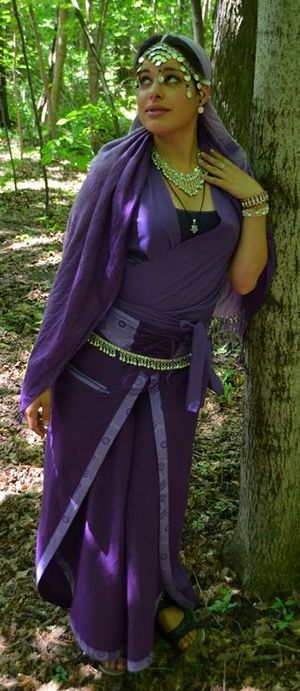Ajaunti
An extravagant, passionate and amicable people, the Ajaunti (“Aja” for short) are a nomadic and colourful race. Where and when the Aja culture came to be is a mystery. Full of life, love and celebration, the Aja place high value in songs, dancing and storytelling. Life never stops moving, so the Aja never stop moving either. Wanderers by choice and welcoming of strangers, Aja “clans” slowly criss-cross the continent in large caravans, following the weather and the winds of fate. The Ajaunti are always willing to share their wine, campfires and wisdom with any willing to join them.
Language: Romanian
Life Expectancy: 60-80 years
| Child | 1 – 13 |
| Teenager | 14 – 19 |
| Young Adult | 20 – 29 |
| Mature | 30 – 40 |
| Middle Age | 41 – 60 |
| Old | 60 + |
History
A tide of good fortune swept over the Ajaunti, known among themselves as the ‘Veri’, recently. In times past, the Ajaunti were nearly universally shunned and mistrusted. With the recent re-emergence of Styphon’s armies, the rise of the Empire and the fall of Melinda – and other large scale conflicts prevalent in these times – the Ajaunti have gained widespread acceptance by acting as merchants and smugglers in times of need.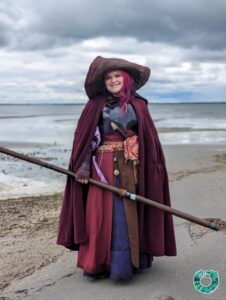
With mercantilism taking a prominent place in their culture, many Ajaunti have taken to the creed “the riskier the road, the greater the profit,” seeking out fortune and adventure by traveling the open road. The Ajaunti have gained a reputation as intrepid entrepreneurs and shrewd negotiators.
The history of the Ajaunti is steeped in mystery and obfuscated by more than a few tall tales. Recorded below is just one of the popular tales told to Ajaunti children – and anyone who will listen.
The Story of Tombas and Greggo
The following story presents a unique take on the Ajaunti origins: while most stories propose that the Ajaunti are descended from humans, this one tells a different tale.
It all began ten-times-ten-times-ten years ago. Two young Hoblings were enjoying a pot of stew under their favourite willow tree. A storm had come in the night before and washed many of the trees roots clean of all their dirt. The two Hoblings, Tombas and Greggo, suddenly noticed a golden flask stuck in the roots of the willow tree.
To’mbas, being the swifter of the two, quickly grabbed the flask and tore it open. A four armed genie – likely a powerful air elemental – flew out in an explosion of light and wind. Without skipping a beat, Tombas exclaimed, “I want to make a wish!”
The genie responded, “As you wish. For releasing me, I will grant you three wishes, but be warned: you cannot wish for additional wishes.” Without a moment of delay, Tombas smirked and wished for the greatest thing he could imagine. He wished for more genies. The genie summoned thousands of flasks, and they crushed poor Tombas to death.
Upon seeing this, Greggo was so scared that he soiled his fancy pants. He ran home to get changed. When he got home, he realised that he could have gotten at least two more wishes out of the genie, so he put on the first pair of pants he could find and ran back to the willow tree. He rushed out of his home wearing a bright green shirt and hot pink pants. When he arrived, he found that the tree, the genie, and even Tombas’s corpse were all gone.
Hoping to use a wish to bring his friend back, Greggo began his quest to find the golden flask immediately. That is why, to this day, the Ajaunti inspect every piece of gold and the bottom of every flask. It is also why they wear mismatched clothing. The Ajaunti are always in a rush out the door, in hopes of finding the genie and saving poor Tombas.
Geography
Ajaunti travel the world and can be found in the furthest reaches of every continent. These are some of the more well-known clans.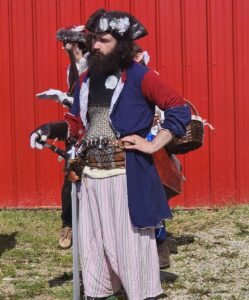
The Purple Clan
The Purple Clan is thought to be the largest and most powerful Ajaunti clan in the world. They travel across the continent of Maud’madir on a circular route, in decade long cycles. The clan is reputed to be full of dark secrets and shady morals. All serve the clan’s ‘Mother’. She is revered by her people and feared by outsiders for her extraordinary Mystical capabilities.
Clan of Fans
An old and well-respected clan spread over much of the world. Many of the smaller clans are offshoots of the Clan of Fans from generations passed.
Barrush Clan
A northern family originating from the Clan of Fans. The Barrush caravans travel through the north of Maud’madir. They follow a circular route between Jormunger, Mjoll and Antioch, breeding horses and carrying specialty goods between cultures that tend not to do direct business with one another.
Clan of Crests
This nautical clan does most of its business with the port cities along the southern coast. While still an inherently peaceful people, the hardships of life at sea and the risks of piracy have taught the Clan of Crests to arm themselves better than their inland cousins. The Clan of Crests is renowned for its colourful stories, acquired through encountering the vast number of cultures they meet along the coast.
Clopotel Clan
Clopotel does a short trade circuit between Aslak and Teris, exchanging Teris’s clever toys for Aslak’s furs and hides. They move quickly and almost without pause from spring to autumn and wait out the winter near Teris, where the climate is more hospitable. Their winter camp is usually just southwest of Teris.
Clan of Silk
Named for their winding path, the Clan of Silk travel a long, twisting trail between Bakura and the friendlier peaks of Le’ever Hashamayim Xyrpmya. Their trail also extends down to Berphaunt, though they make that journey less frequently, preferring to keep to the mountains where life is more peaceful and their clients are better known to them.
Ryazan Clan
The Rayazan Clan travels primarily in and around Tiefanue. They are known for their strict marriage laws: they always marry out of clan, and the daughters leave to join the clans of their husbands. It is expected that any woman who wants to marry into the clan does the same. It is common for the sister nearest in age to the bride to travel with her to the new clan as a companion. The Ryazan Clan has a rigid custom of covering their women’s hair. Some say the extreme modesty of Ryazan women may indicate a much wilder life behind closed doors, though only their husbands could know this for certain.
Clan Vinatoare
Clan Vinatoare is a reclusive clan, travelling in pursuit of witches and other unclean magic which must be destroyed. While Vinatoare caravans can be found all across the continent, their calling brings most Vinatoare caravans to the forests of Berphaunt, where the evil spheres are legal and flourishing.
Yorouk Clan
The Yorouk Clan is a Duvainian clan which prefers to travel the south. Yorouk’s traditions are more symbolic than most. The leader, or ‘Mother’, of this clan must always be unwed and childless. Her clansfolk are her only children, and they will address her with names like ‘Mother’ or ‘Mama’ in respect of that. The Yorouk Clan believes that patterned fabric distracts and confuses evil spirits.
Clans
 Although the Ajaunti are a diverse and far flung people, with cultural practices varying between traveling groups, almost all Ajaunti conform to a clan-based structure. The clan is central to the life of an Ajaunti. The Ajaunti clan travels together, drinks together, sleeps together, and performs rituals together. Clans are family.
Although the Ajaunti are a diverse and far flung people, with cultural practices varying between traveling groups, almost all Ajaunti conform to a clan-based structure. The clan is central to the life of an Ajaunti. The Ajaunti clan travels together, drinks together, sleeps together, and performs rituals together. Clans are family.
The Ajaunti clan is an organisation ranging from 10 to 1000+ members. If a clan ever drops below 10 members it will no longer be considered a clan, and no new clan of less than 10 members may be created. There are no limitations on who can make or join a clan, as long as its members are Ajaunti. Sometimes a non-Ajaunti will be allowed to travel with a clan, but they will never have a voice in clan affairs and are seen as welcome, but temporary, guests. Most clans travel together, wandering the world as a group. When clans grow too large, through recruitment or fertility, the clan may subdivide into smaller travelling bands. When a clan breaks up in this way, the bands usually try to orchestrate a meeting once every other year, to keep the ties between the clans strong.
There is no consistent organisational system among the Ajaunti clans. Systems of organisation range from leadership by the clan elders or elected councils to total anarchy. The most common system is a matriarchy, wherein the leader of the clan is referred to as the ‘Mother’.
One might think of Aja as carefree people whose loyalty to clans would change on a whim, but this is not the case. Clans are particularly important to Ajaunti, as an Ajaunti can only perform certain ceremonies with members of their own clan. To an Ajaunti, a clan is their family, and family means everything. There are fewer things more important to an Ajaunti than their clan, so joining and leaving clans is taken very seriously. Ajaunti clans can vary wildly in their traditions and rituals, except in one way: the rites involved in joining, leaving, and being expelled from the clan.
Joining a Clan
To join a clan, a clan-less Ajaunti must petition the most senior clan member available once a day for three days in a row. Each day, they must fulfill a request – sometimes great, sometimes menial – and must provide a gift of some type. The more important or valuable the gifts, the greater the desire to join is assumed to be – sentimental items, such as a departed mother’s wedding ring, may be considered more important than a wagon full of gold. It is up to the clan leadership to judge each gift’s worth. On the third day, the senior clan member will choose to accept or reject the new member. If they are rejected, they may attempt to join again, but the tasks and gifts must be even greater, sometimes impossibly so. An Ajaunti may never be a member of more than one clan at a time.
Creating a clan is relatively simple. A minimum of 10 Ajaunti must agree on a clan name and customs. A leader or leaders should be decided. There is then a toast to each individual, then to the clan itself, and finally to the ancestors. From that point forward they are now a clan, and a family.
Leaving a Clan
Leaving a clan is not uncommon among the Ajaunti, especially among reckless youths. The process for leaving a clan may differ slightly between clans, but generally involves the Ajaunti in question making a very public announcement of their desire to leave the clan. Usually an item is broken as a symbolic gesture that ties are now severed. Once an Ajaunti has left a clan it is tradition that they may not re-join it for at least a year, or sometimes longer.
Exile from a Clan
Exile from a clan is a very serious matter, though the rite is easily executed. To exile a member from the clan, another clan member, generally the leader, must loudly announce “May you find your roots” and turn their back on the exile. This is, of course, a fairly serious insult among Ajaunti, who despise being tied to any one place. The rest of the clan will follow suit. If the exiled member is not physically present, a representation of them may be used instead, such as a doll or carved wooden figure. Ajaunti who have been exiled from a clan may never rejoin it unless they single-handedly save the clan from great harm or destruction.
Ancestor Worship
For reasons lost to time and ale, the Ajaunti have never truly embraced the worship of either the dragons or the gods. Instead, they have focused on ancestor worship. The Ajaunti do not see their ancestors as dead and gone, but ever-present, watching over them. Ajaunti will often speak to their ancestors as though they were in the room with them. Unlike other major faiths, Mysticism, not magic, is their primary avenue to the divine. This worship is not unfounded. In times past, Ajaunti were able to invoke their ancestors in the infliction of powerful curses, and now the Ajaunti are able to use them to summon great ritualistic power.
While every clan is organised differently, almost every single one will have a seer; a person dedicated to communicating the will of the ancestors. The seer, often a psionicist or mystic, is a person of valued council in times of great conflict or peril.
Politics
The Bazaar
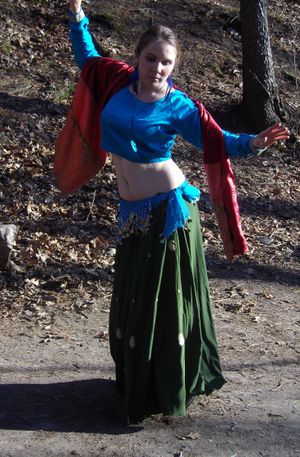 While the Ajaunti as a race lack any cohesive organisation or structure, there are stories of a grand meeting of all the major clans: the Bazaar.
While the Ajaunti as a race lack any cohesive organisation or structure, there are stories of a grand meeting of all the major clans: the Bazaar.
The Bazaar is a gathering of all of the Ajaunti clans able to attend. It is a place where long lost feuds and friendships can be rekindled, where clan alliances can be made or broken, and where no blade may be drawn. The Bazaar is hallowed ground.
The Ajaunti do not organise a Bazaar; they are called to it. Without pattern, reason, or warning, the seers of the Ajaunti clans will be given visions known as ‘The Hearthfire’. The Ajaunti are a race without a home, but after experiencing the Hearthfire the seers will begin to feel homesick, for the first time in their lives, for a place they have never been. Over the course of a month, the seer will experience dreams which detail the path to the site of the Bazaar, and are compelled to direct their clan to the site. Ajaunti tales tell that clans who refuse the advice of their seer are plagued with misfortune.
No two Bazaars have ever been held in the same place, but they are always held at a site where two rivers meet. Clans will set up camp on the outer shores of the rivers, while the point of land between them is reserved for the pending market area. At the point of land where the two rivers meet, a circle of wagons will be established, with one wagon from every Clan. It is here that the grand meeting, called the ‘Confluence’, will be held.
Once at the Bazaar site, each clan’s seer will choose a speaker for their clan, and the speaker and seer will join the Confluence. The seers will join together in a grand ritual in which they petition the ancestors for an insight as to why the Bazaar was called. In the grand history of the Ajaunti, there are no reliable stories of this petition ever being answered.
While the seers are in their trance, the clan speakers will pass around a cup and introduce themselves while reciting any major events which have happened to their clans since the last Bazaar. This may take a while, as sometimes decades can pass between these meetings.
The Confluence will last throughout the first day and first night of the Bazaar, and is dismissed at sunrise. The seer and the speaker are allowed to return to their clans and join the festivities. After a few nights, but never longer than two weeks, the seers will receive a second vision, ‘The Peregrination’, in which they feel the compulsion to abandon this place at once. Without delay, the caravans are packed up, clan members are accidentally swapped, and the clans scatter to the winds and resume their endless wandering.
Common Personalities & Views
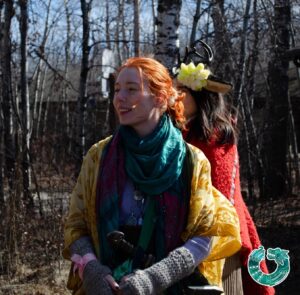 The Ajaunti are a traveling people, and a mercantile one. For an Ajaunti, just one bad trade can mean the difference between living the high life or starving in the streets. Everything is a commodity: happiness, information, friends, and all must be brokered with care. The Ajaunti are not out to swindle anyone, but it is of importance to them that no one takes advantage of their hospitality. They only seek a fairness of exchange for what they may provide. Presented here are a few common personalities among the Ajaunti.
The Ajaunti are a traveling people, and a mercantile one. For an Ajaunti, just one bad trade can mean the difference between living the high life or starving in the streets. Everything is a commodity: happiness, information, friends, and all must be brokered with care. The Ajaunti are not out to swindle anyone, but it is of importance to them that no one takes advantage of their hospitality. They only seek a fairness of exchange for what they may provide. Presented here are a few common personalities among the Ajaunti.
The Merchant
The thing with adventuring is that you tend to find a lot of weird stuff lying around. While most of it may seem useless, a good merchant can tell who needs what, and how badly they want it. These Ajaunti strive to be everyone’s second best friend, as everyone is a potential customer. Getting to know people is a great way to avoid loneliness – and to figure out what it is that people want to buy. With a sharp eye, silver tongue, and a quick hand, you can ‘salvage’ such items from the battlefield, or buy them off people who have not the wherewithal to know what to do with them. Most of all, these Ajaunti remember the old Ajaunti saying: “friends are friends, but business is business”.
The Socializer
Ajaunti are known for their wild parties, amazing stories, and outgoing disposition. For many, being an Ajaunti is synonymous with making friends and meeting strangers. The social Ajaunti is indispensable to an adventuring town. From introducing new adventurers to their future friends, to being the shoulder to cry on, or just always seeming to know who is up to what, the Socializer is the Ajaunti who knows how to tie people together, because they know that every great story begins with a group of strangers.
The Story Teller
So much happens in the life of an adventurer, if only someone could remember to write it down. Thankfully, the Storyteller can rise to the occasion. While all Ajaunti love telling stories, not all bother telling truthful ones. By remembering the events of the past, sometimes in exaggerated detail, the Storyteller ensures that no minor point of information falls through the cracks. The Storyteller is always eager to hear the tales of everyone’s most recent exploits before they forget, and commit them to memory for later use. You’d be surprised how many people will take stories over coins.
The Tinker
Every Ajaunti clan seems to have at least one Tinker. A staple in the daily life of the clan, the Tinker is always there to patch up broken pots or unbend worn out tools. For the Tinker, nothing is off limits to explore. Always wondering how things work and what makes things tick, you can expect the Tinker to dabble in a wide variety of skills. They are well prepared to inspect any exciting eccentricity they encounter. Besides, in an adventuring town, a blacksmith is never out of work.
The Seer
Every clan needs a Seer. Ancestor worship is a significant part of Ajaunti society, and those who possess the ability to communicate with the dead are revered. Seers are often eccentric and far too distracted by the spirit world to be bothered with the here and now. Talking to invisible people, ceaseless muttering, and random bouts of laughter and crying are all hallmarks of the Ajaunti mystic. The nature of their visions, and the method of their augury, is up to the player, but classics like tarot cards and crystal balls are always a great starting point.
Views on Other Races
Humans: “How could anyone ever compare us to these boring sticks-in-the-mud? Sure, yes, a few of them may have the same amazing wanderlust as we do. But let’s be honest here, it’s probably because they have a secret Ajaunti father that their mothers never told them about!”
Einher: “Never was a race of people so close to perfection, but yet so far away: They have a strong wanderlust, they enjoy a good fur coat, they love gold and drink… It’s almost as if they were trying to emulate us out of admiration! It’s a shame that they keep murdering everything they run into.”
Hoblings: “Hoblings are among the greatest creations in the world. They have always welcomed our caravans with the pinnacle of hospitality and cooking. They are content to live their lives at home and let the world come to them, and we are happy to bring it to them! Hoblings enjoy all of the same vices we do: Food, drink, fine clothes, and a good shindig!”
Dark Elves: “A year ago, my Uncle was killed by one on some quest of vengeance. Vengeance, pah! I hope their cavern collapses right over top of their creepy churches.”
Grey Elves: “Who?”
High Elves: “These Elves are so high-and-mighty, there is good reason most floated up to the clouds on a rock. And look where that got them! We do not see eye-to-eye, but they are a decent folk.”
Ice Elves: “The best part about Ice Elves is the bounties the Einher put on them.”
Wild Elves: “These guys are great! They dress in muted earth tones, place almost no value in gold, and oh! I almost forgot! They murder us in woodland ambushes if we accidentally stray into their forests. Yeah, they are the cream of the crop, they are.”
Fae: “As my grandmother used to say, “it’s all fun and games until somebody says ‘thank you’”. Be mindful of who you’re dealing with.”
Dwarven Races: “I have a hard time telling the different dwarves apart. They never let you set up camp inside their halls, but they will often give you a designated campground. Truth be told, the dwarves need our wares, and our trade routes. Stuck inside those halls, there are a lot of things they can’t get for themselves. They’ll tolerate our presence nearby and send merchants to deal with us, but they never let their guard down.”
Goblins: “They raid our caravans, abduct our cousins in their sleep, and skulk about dark places with long knives and malicious intent. However, I have heard stories from the elves that some goblins can possess a unique, redeemable trait that allows them to achieve goodness. It is only these goblins who are good goblins. I am of course talking about dead goblins. The only good goblin is a dead goblin.”
Bestial Races: “With exception to Fauns and some of the Savar’Aving, the bestial folk are too territorial or border-heavy to allow us to camp near them. We don’t hold it against them, but it does prevent our cultures from blending.”
Roleplaying Tips
The Ajaunti clans are some of the most diverse in the world. When building your character, don’t be afraid to make up your own accent, attire, and mannerisms. Even Ajaunti from the same clan might have wandered to vastly different places in the world, and have completely different behaviours. Thrift stores are great places to raid for eccentric costume pieces. Try to assemble outfits that are practical for your character, in period, and visually appealing – at least to your character.
Clans are incredibly important to most Ajaunti. Someone living on the road may make a ton of friends, but it’s your clan that you can really count on as you travel. Life on the road is incredibly challenging, so most Ajaunti become fairly durable, good humoured and, most of all, clever. Ajaunti are generally boisterous, friendly people, and have a penchant for parties.
Most Ajaunti do not worship dragons or gods, but their ancestors. They are also typically very superstitious, so try making up your own fun superstitions and roleplaying them, eg: “Never trust a Wild Elf with dyed hair” or “Never cut your hair on a Thursday”.


